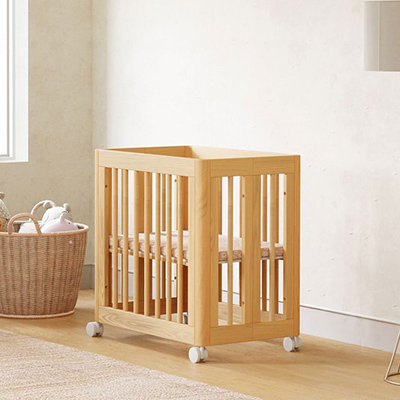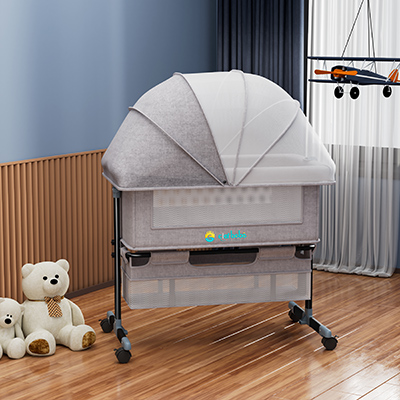When it comes to selecting the ideal sleeping solution for infants, the choice between a mini crib and a bassinet is a crucial one. In this article, we'll delve into the intricacies of both options, offering a detailed comparison to help your customers make the best choice for their little ones. Understanding the nuances between mini cribs and bassinets will empower you to guide your customers towards making informed choices that prioritize comfort, safety, and style.
|
Aspect |
Mini Crib |
Bassinet |
|
Size |
Slightly larger, suitable for longer use |
Smaller, ideal for early months |
|
Longevity |
Converts to toddler bed, extended use |
Short-lived, ideal for newborn phase |
|
Mobility |
Bulkier, less portable |
Highly portable, easy to move around |
|
Accessories |
Provide storage, drawer, convetible options |
may have vibrating and music feature |
|
Convenience |
Built-in storage adds convenience |
Easier access for nighttime feeding |
|
Durability |
Sturdy, designed to withstand child's activity |
Delicate materials, shorter usage span |
|
Versatility |
Suitable for sleep and play |
Primarily designed for sleeping |

source: Pinterest
A mini crib is a compact version of a standard crib, designed to provide a safe and comfortable sleeping environment for infants and toddlers. Mini cribs are an excellent choice for parents who want a durable and lasting option that can accommodate their child as they grow. With features such as adjustable mattress heights and convertible capabilities, mini cribs offer versatility that extends beyond infancy.

A bassinet, on the other hand, is a small, portable bed specifically designed for newborns and very young infants. Bassinets are typically lightweight and easy to move around, making them ideal for parents who want their baby to sleep nearby during the early months. They offer a cozy and snug sleeping space that can provide a sense of security for newborns.
Size: Mini cribs are larger and resemble a smaller version of standard cribs. Bassinets are smaller and intended for the earliest stages of infancy.
Age Range: Mini cribs can accommodate infants through their toddler years. Bassinets are suitable for the newborn stage up to a few months old.
Portability: Bassinets are highly portable due to their compact size, whereas mini cribs are less portable.
Longevity: Mini cribs can be used for a longer duration as they accommodate a wider age range. Bassinets are outgrown relatively quickly.
Features: Mini cribs often come with convertible options, such as the ability to transform into toddler beds. Bassinets are designed with a primary focus on providing a comfortable sleeping space.
Versatility: Mini cribs are suitable for both sleeping and playtime. Bassinets are primarily designed for sleeping.
Usage Areas: Mini cribs are commonly placed in nurseries or dedicated baby rooms. Bassinets are often used in parents' bedrooms for convenient access to the baby.

Pros:
Longevity: Can be used for an extended period.
Convertibility: Some models can be converted into toddler beds.
Versatility: Suitable for sleep and play.
Durability: Designed to withstand the active years of a growing child.
Cons:
Size: Takes up more space than a bassinet.
Portability: Less portable due to its larger size.

Pros:
Portability: Easy to move around, ideal for keeping the baby close.
Coziness: Provides a snug and secure sleeping environment.
Space-Efficient: Fits well in smaller spaces.
Cons:
Short Usage Period: Outgrown relatively quickly.
Limited Features: Primarily designed for sleeping.
Q1: Can a mini crib be used from birth?
A1: Yes, mini cribs can be used from birth. They provide a larger sleeping area suitable for newborns and can be used as a long-term sleep solution as your baby grows.
Q2: Are bassinets only for nighttime sleep?
A2: Newborn bassinets can be used for both nighttime sleep and daytime naps. Their portability allows you to keep your baby close wherever you are in the house.
Q3: Can a bassinet replace a crib entirely?
A3: While bassinets are perfect for the first few months, they are not a long-term solution. Babies outgrow them quickly, and for safety reasons, a crib or mini crib is necessary as they become more active.
Q4: Do mini cribs require special mattresses?
A4: Yes, it's important to use a mattress specifically designed for your mini crib. The mattress should fit snugly to prevent any gaps that could pose a safety hazard.
Q5: Are bassinets easy to assemble and disassemble?
A5: Yes, most baby bassinets are designed for easy assembly and disassembly. This feature adds to their portability, making them suitable for travel as well.
Q6: Can I use a mini crib in a small apartment?
A6: While mini cribs are larger than bassinets, they are still space-efficient compared to full-size cribs. Their added storage options can also help in optimizing space.
Q7: Do bassinets have weight limitations?
A7: Yes, bassinets typically have weight restrictions that vary by model. Always check the manufacturer's guidelines to ensure your baby's safety.
In conclusion, the choice between a mini crib and a bassinet ultimately depends on your customers' preferences, lifestyle, and available space. Both options offer unique advantages, catering to different stages of a baby's early life. As a trusted baby furniture owner, you can now confidently guide parents in selecting the perfect sleep solution that aligns with their needs and desires.
Related Posts
Top Baby Furniture Manufacturers - The Ultimate Guide
Best Baby Crib Manufacturers in UAE
Best Baby Cribs in 2024: A Complete Guide
Cribs vs Bassinets vs Cradles - Which Is Right for Your Baby?
Mini Crib vs. Bassinet(Meaning, differences, pros and cons)
Crib vs Cradle vs Bassinet (Meaning, Differences, Features, Benefits)